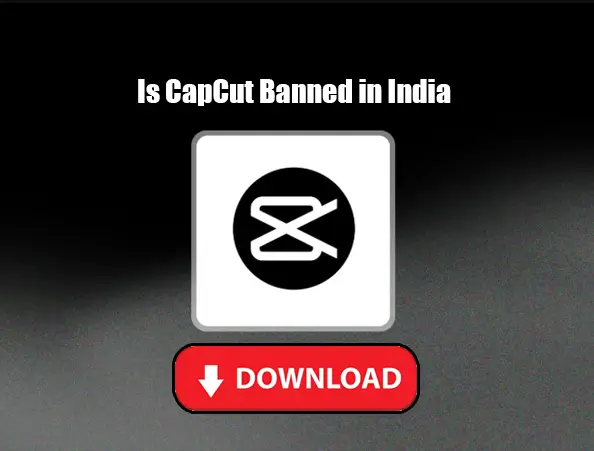The digital landscape in India has experienced seismic shifts in recent years, as app bans have become a new normal for Indian users. One app that has found itself at the center of controversy is CapCut, a widely popular video editing tool developed by ByteDance—the company behind TikTok. Known for its user-friendly interface and professional-grade editing features, CapCut quickly became a favorite among Indian content creators and social media enthusiasts.
However, in a shocking turn of events, CapCut was banned in India in June 2020, leaving millions of users scrambling for alternatives. If you’re a content creator or just curious about the situation, this guide explores why CapCut was banned, its current status, and what this decision means for Indian creators in 2024.

A History of App Bans in India
India’s wave of app bans began in June 2020, when the government announced the prohibition of 59 Chinese apps, citing concerns over data privacy and national security. This massive crackdown included some of the biggest names in the tech space, such as TikTok, WeChat, and UC Browser.
CapCut was among the apps that were permanently banned under Section 69A of the Information Technology Act. The government declared that these apps posed threats to user data, as many of them were accused of unauthorized data harvesting and transmitting sensitive information to servers located outside India.
These sweeping changes were a direct response to border tensions between India and China, but the actions highlighted India’s growing emphasis on digital sovereignty and the protection of its citizens’ private data.
Why Was CapCut Banned in India?
1. The Privacy Predicament
At the heart of India’s decision to ban CapCut and other Chinese apps is the protection of user privacy. The Indian government raised concerns about the potential misuse of user data collected by these apps, which, it alleged, could compromise the privacy and security of Indian citizens.
2. Chinese App Exodus
CapCut was part of a broader ban on apps originating in China. This was a calculated move to reduce dependency on Chinese software while fostering an ecosystem of Indian-made apps.
3. TikTok Connection
Being owned by ByteDance, the company behind TikTok, CapCut faced additional scrutiny. Its ties to TikTok meant that any concerns surrounding TikTok’s data practices extended to CapCut as well.
Is CapCut Still Banned in India in 2024?
Yes, CapCut remains banned in India as of 2024. The app has not reappeared on the Google Play Store or Apple App Store within the country. The ban is still enforced under the same regulations introduced in 2020.
While some speculate that ByteDance could eventually address the government’s concerns in an effort to lift the ban, no official announcement or progress toward reinstating CapCut has been reported.
For Indian users trying to access the app, workarounds like VPNs have emerged as a temporary fix, although such methods are not without challenges.
Alternatives to CapCut for Indian Users
The ban on CapCut does not mean Indian creators are left without options. There are excellent alternative video editing tools available, each offering unique features for content creation. Here are three top picks for Indian users:
1. Filmora
Filmora is a versatile video editing tool perfect for both beginners and advanced creators. It provides professional effects, templates, and an intuitive interface, making it a worthy alternative to CapCut.
2. InShot
A popular mobile app, InShot offers robust editing features like trimming, transitions, and music integration. It’s an excellent choice for creators seeking quick edits for Instagram Reels, TikTok, or YouTube Shorts.
3. VN Video Editor
VN Video Editor is a free tool that delivers professional-grade video editing with features like multi-layer editing and advanced color grading.
How Does the Ban Impact Indian Content Creators?
Indian content creators have felt the ripple effects of CapCut’s absence. Many of them relied on its advanced yet straightforward editing features to create polished content across platforms like Instagram, YouTube, and TikTok (before TikTok’s own ban). The unavailability of CapCut means creators now have to spend more time or money on less user-friendly tools to achieve the same results.
For small creators with limited resources, such disruptions can hinder their content production schedules and reduce their competitive edge in the fast-paced world of digital media. However, the availability of quality alternatives like InShot and Filmora helps cushion the blow.
Beyond inconvenience, the ban also highlights the broader impact of technology regulations on creatives, serving as a reminder of how geopolitics can shape even the most personal aspects of our digital lives.
What Lies Ahead for CapCut in India?
The future of CapCut in India hinges on several factors, including how ByteDance addresses the Indian government’s privacy concerns and reassures policymakers about user data security.
If the app can align itself with India’s digital policies, there is a possibility that the ban could be revisited. However, until then, Indian users should explore alternative tools that not only meet their editing needs but are also compliant with local regulations.
Final Thoughts
While CapCut remains banned in India in 2024, content creators and social media users still have access to a range of alternatives that cater to beginner and professional needs alike. This regulatory reality underscores the growing importance of secure data practices and digital sovereignty, which are shaping how we interact with apps in the modern era.
For Indian creators seeking seamless editing features, tools like Filmora, VN Video Editor, and InShot will ensure your creativity doesn’t skip a beat.
Have you tried any alternatives to CapCut? Are there specific editing tools you’d recommend? Share your thoughts in the comments below!




